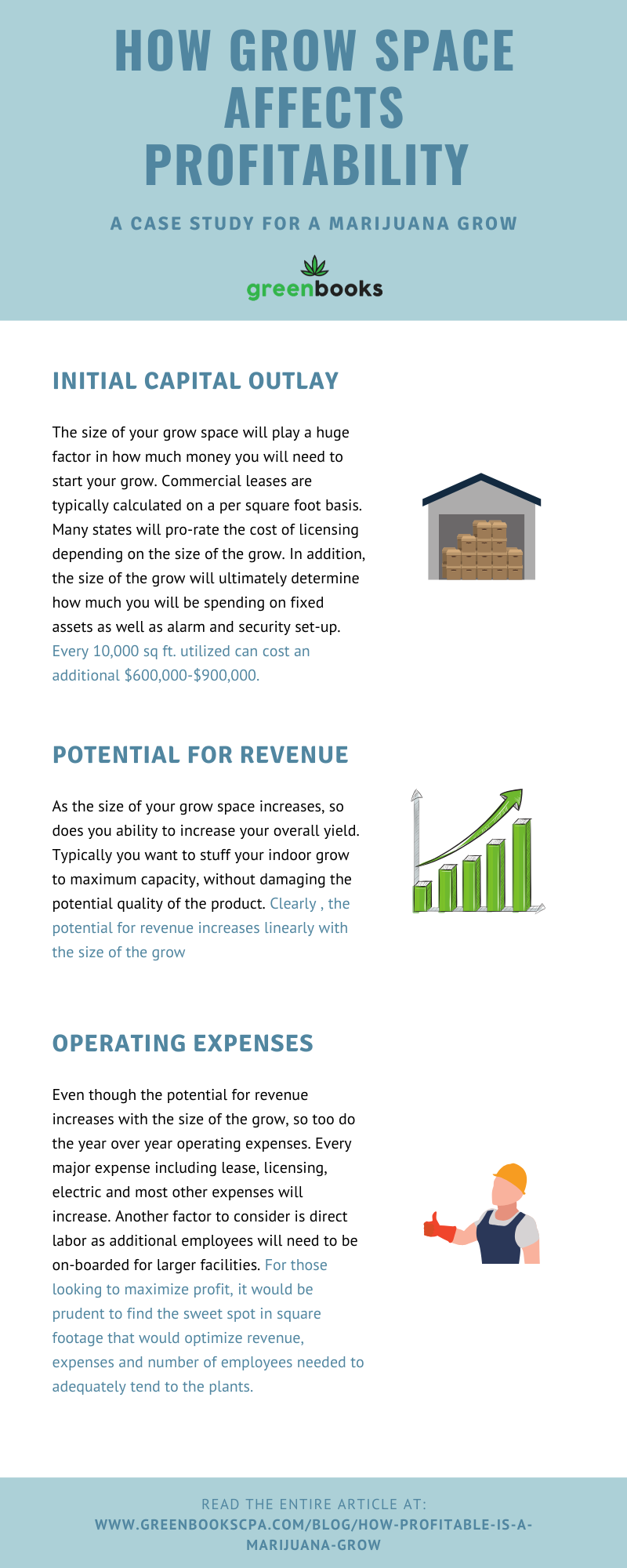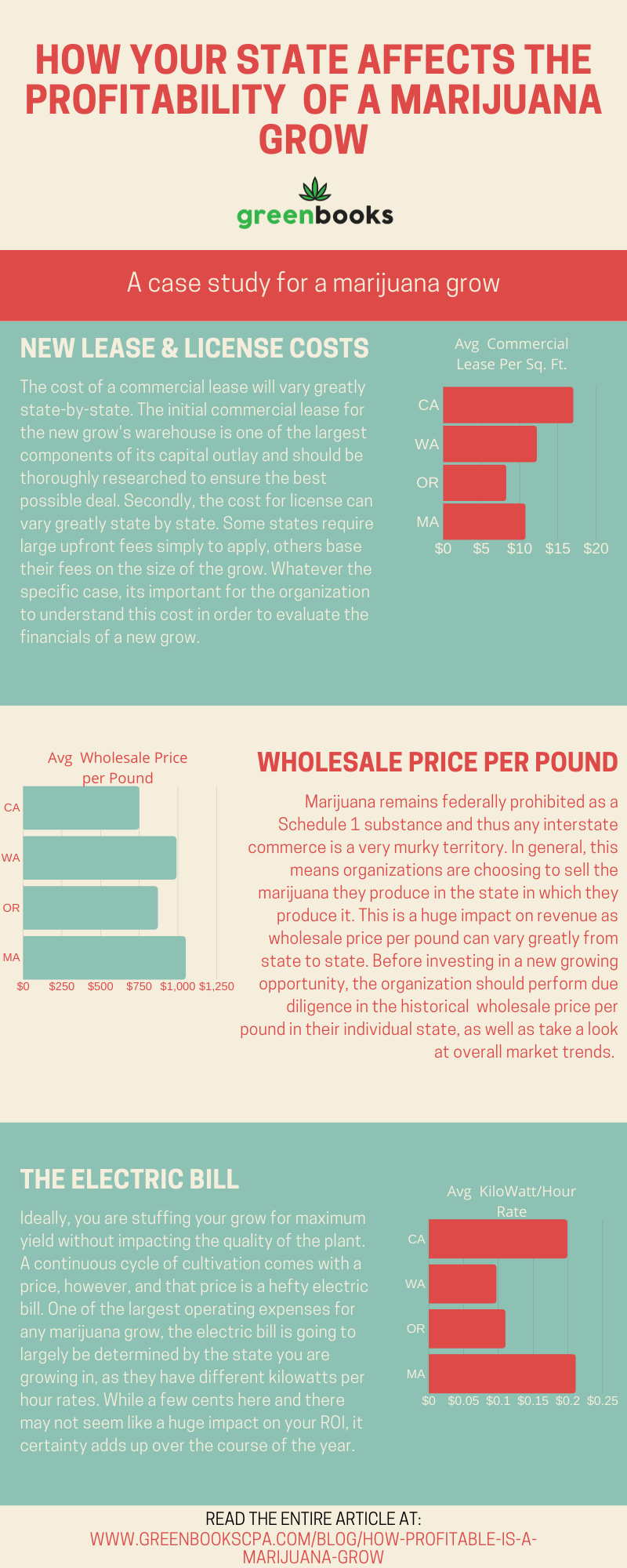Cannabis Profitability: How Profitable is a Marijuana Grow?
*Intended for informational purposes in adult-use legal states only
Cannabis has a long history as being a symbol of the counter-culture. Over the last five decades, the general public has been educated about the medicinal benefits of cannabis and public opinion concerning the plant has shifted dramatically. Long time cannabis enthusiasts fear that as private capital continues to be pumped into the space, corporate culture will slowly become the norm in the cannabis industry. Nevertheless, businesses must produce a profit to survive and the burning question for many is just how profitable is growing cannabis?
Cannabis cultivation is a profitable, albeit risky venture at this point in time. It is also a relatively complex undertaking with many factors to consider prior to starting a grow. This article will primarily be focused on discussing mid-size marijuana grows - not something you would quite do in your backyard at home. The three primary factors in the profitability of your cannabis grow will be:
The Size of the Grow Room
The State the Grow is Located and
The Lighting System
For purposes of this exercise, we will simplify some of the financial components regarding capital outlay, revenue and operating expenses. The intention is to show ballpark estimates for these figures,so that readers can get a general sense of what the operational financials of a grow could look like. Whether more wattage means higher quality product or if a certain square foot grow space would require more or less labor is still up for debate - we can address specifics like these in a later article.
Our initial capital outlay will be an estimate of how much capital we need to start a new marijuana grow. Included in that would be:
Initial Lease & License - State dependent but typically based on the square feet of the grow
Initial Lighting System, Growing Equipment and Warehouse Preparation - This would essentially be your investment into fixed assets
Initial Alarm & Security Set-Up & Other Admin Fees - These would be expenses that could not be capitalized
For the revenue portion of the analysis, we will be using a total yield per watt model. Different lighting systems will produce different yields. Of course, in reality, the skill set of your staff will also have an impact on this number, but that is not accounted for in this model. The wholesale price per pound will be dependent on the state, assuming there is no interstate commerce of marijuana for this organization.
Finally, when looking at Year 1 Returns, we will calculate revenue based off of yield and wholesale price per pound. We then account for some of the largest year over year expenses including
Annual lease expense (with escalation)
Annual license expense (with escalation)
Annual electric bill
Cost of direct employee labor
Other Expenses (which inevitably occur)
Putting it all together, take a look at the model below and try influencing the returns by pulling on the three levers (size, state and lighting system). This is a useful reference point before diving into some of the details how and why these are the most important factors of profitability.
#1) The size of the grow space
The most important consideration of profitability when it comes to a new growing opportunity is of course the size of your grow space. Consider all of the basic elements of the initial capital outlay to start a new grow: the initial lease of a new space, the license to operate as a cannabis company, all of the growing equipment,how much it will cost to prepare the space for growing. All of these costs are directly correlated to the size of the grow space. On the year over year revenue and expense side, the most important revenue driver for your new grow will be how many ounces (or pounds) your grow can yield annually. Your grow space will also play key component in large year over year expenses such as your utility bill and direct labor.
From an initial capital outlay perspective, your largest cost will likely be your lease. Leasing a smaller warehouse may leave room for some negotiation, but typically a capital lease will be determined by square feet. In many states, the cost to apply and secure a license will also be correlated to the size of grows being planned by the company. This is potentially an important tax/accounting consideration with respect to cost of goods sold. Consider some other costs that the size of the grow space impacts in a secondary manner. While, for example, the costs relating the initial lighting system, growing equipment or warehouse preparation will not be directly correlated to the size of the warehouse, you ultimately will only have so much space to fit these assets.
When it comes to revenue, yield is king. Grow space will of course be a key component. When it comes to strategically planning your grow in advance, you typically want to stuff your grow with as many plants as possible, while not damaging the potential quality of the product. Naturally, a larger space will allow you to produce a higher yield. The grow space is also the key limiting factor on how much money your grow can produce.
For year-over-year operating expenses, size will play a primary role in both lease and license costs. When planning any grow, it is prudent to assume there will be an escalator on the annual cost for both the lease and license. While not a direct contributor to the electric bill, your total grow space of course quantifies the maximum dimension this expense will be. Also consider direct labor. You could probably take care of a 500 square foot grow yourself. How about 10,000 square feet? 50,000? As the scale of your operation increases, you will need to increase headcount to accommodate all of the work.
#2) The state where the grow is located
The state of your grow is surprisingly important in its potential profitability. The three ways in which the state make the biggest impact on profitability are license expense, revenue from wholesale price per pound and the operating electric bill.
One of the most difficult parts about participating in the cannabis industry is obtaining a license from state and municipal government. Regulatory nightmares aside, they can be extremely expensive and their costs can vary widely on a state-by-state basis. As we mentioned, some states price licenses depending on the square footage of the grow. Others have large upfront fees to apply, regardless of the size of the grow. With no standardized process across the country, its extremely important to take into careful consideration the state you intend to setup a grow in. How that state goes about licensing and the associated costs could potentially be a huge drain on your upfront capital.
From a revenue perspective, its extremely important to thoroughly research the historical price per pound of wholesale cannabis products. Keeping in mind we only have about a half decade of useful data, we've seen a clear pattern emerge regarding wholesale price per pound within states. In the immediate year following adult use legalization, we tend to see a very high sales point in price per pound. As the market adjusts to understand regulations, supply tends to flood the market, reducing the wholesale price per pound continuously. Prices are often cut half from the first year of legalization within 3 years. This is an important factor to consider because even though multi-state operators do exist, it could be considered illegal to traffic marijuana products between states.
When it comes to the year over year operating expense, the electric bill will routinely be one of your largest costs. Although what equipment and lighting system you install will play a big factor in this expense, your state will determine how much you are paying per kilowatt hour. Once again, if profitability is your primary motive, you would ideally have your grow supplying lighting, cooling etc to your plants basically 24 hours a day. In 2019, the price per kilowatt hour ranged from a low of 9.37¢ / kWh in Louisiana all the way to 32.76¢ / kWh in Hawaii, more than 3 times larger. Considering the impact the state can have on initial capital requirements by way of license, in potential revenue for your grow and year over year electric expenses, it is apparent why it is an extremely important consideration.
#3) The lighting system
The ideal lighting system setup to grow quality cannabis is a hotly contested topic, far above the scope of this article. Nevertheless, in most grows, the lighting system is very important from an accounting and financial perspective as it is among the only fixed assets. The lighting system impacts the financial viability of a new grow in three primary ways. First, the initial upfront cost of equipment is typically a material cost and some lighting systems will be cheaper than others. Secondly, the total yield of the grow can be reliant on how many watts your lighting system is comprised of meaning your lighting system makes a direct impact on revenue figures. Finally, you will pay for additional wattage through the electric bill in your year over year expenses.
When it comes to dealing with lighting systems in cannabis, price typically increases linearly with wattage. As we noted, there are a wide variety of opinions when it comes to the optimal setup when growing cannabis. Although higher wattage setups tend to increase yield, it may not be true for every scenario. The lighting system is an important consideration for a new cannabis grows both financially and operationally. For a medium size grow however, we can assume in most cases a higher wattage setup is generally more sophisticated and increases the costs relating to materials. Many small to medium size grows simply don't have the capital to install and maintain the most advanced lighting systems.
Although limited by the size of your new grow, the lighting system you select will have a large impact on your yield. There is a general thought in the cannabis industry that a lower wattage system will produce plants with a higher yield, while a higher wattage setup may be more likely to produce a higher quality plant. The jury on this wisdom is still out. With marijuana being illegal for so many years, it will be a little while before peer-reviewed scientific studies concerning the correlation between lighting systems and marijuana yield are conclusive. In the meanwhile, for purposes of this model, we assumed that a 1000W lighting system would yield about 1.30 grams per watt whereas a 2400W lighting system would yield about 1 gram per watt. If you tinker with model, you can see this can have a massive financial impact on your grow, depending on the scale.
With great wattage, comes great responsibility. While state of the art lighting equipment could mean a huge increase to your annual yield and revenue it also comes with a price in the form of an electric bill. Most states will bill your electric usage on a kilowatts per hour usage which means a state of the art lighting system could end up costing you big time on a year over year basis. Growers have to weigh the risk and opportunity when it comes to installing new, more expensive lighting systems. Will the increase in yield be able to cover my initial capital outlay as well as my more expensive electric bill? Do I believe that the price per pound of marijuana in my state is sufficiently stable to justify investing in this new asset long term?
After diving in some of the specifics, take a look again at the model. One thing which jumps out is that the returns are absolutely fantastic - so long as the wholesale price per pound in your state is relatively high and stable. We discussed the three main influential factors in the profitability of your grow that you could control. Unfortunately, this is probably the most important factor and its probably out of your control.
Any cannabis company, new or existing should go through something similar such as the above exercise when deciding on ANY new opportunity. The above is a fairly simple model that lacks nuance - the models your company puts together when pursuing new opportunities should be extremely well researched and documented for your unique situation. We provide such a service to the cannabis industry. Good financial planning for your organization often makes the difference for achieving your goals.




